Disclaimer: This article may contain affiliate links. Clicking on them may earn Costa Rica Vibes a commission, at no extra cost to you. Thank you for your support!
Butterflies in Costa Rica – The Best Places to See Them
Butterflies in Costa Rica can be found all over the country. In fact, Costa Rica is home to 18% of the world’s butterfly species. Yeap, there are thousands of different butterfly species flying around here. How cool is that?!?
Although the country is home to tons of varieties of butterflies, the most popular butterfly is definitely the Blue Morpho.
Interested in knowing what exactly a blue morpho is and where you can spot one? Well, let’s get to it!
Types of Butterflies in Costa Rica
I am not going to list the thousands of butterfly species in Costa Rica, but here are the notable ones that you may see while visiting Costa Rica.
Blue Morpho Butterfly
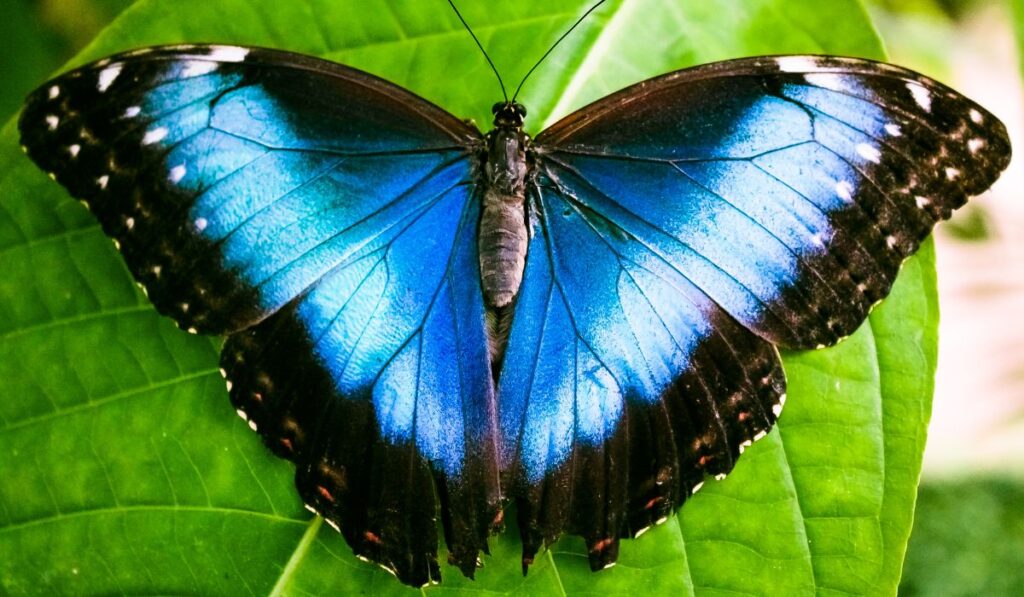
The bright blue inside of this butterfly is extremely intense and striking. However, when its wings are closed it does not look like much. These butterflies are almost impossible to take a picture of. You will have to get lucky and snap a shot when their wings are spread.
Fun Fact: Only the male Blue Morphos have the bright blue coloring. Females are actually rather dull looking.
Monarch Butterfly
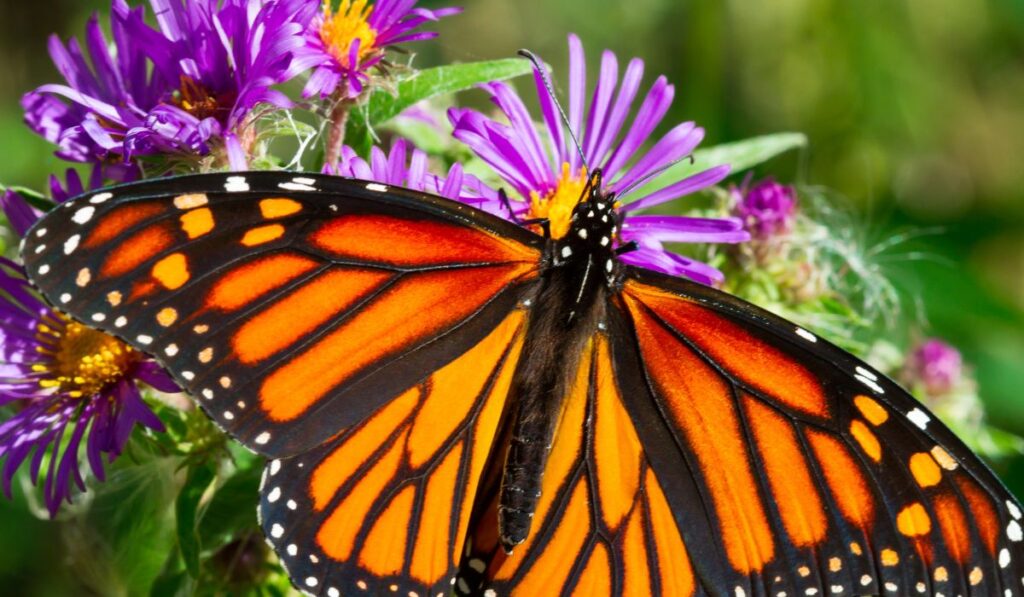
Monarch butterflies are often considered the most recognized butterfly in the world with their bright orange and bold black coloring.
This coloring is actually a signal to predators that they are poisonous. See, their diet consists mostly of milkweed, which is not poisonous to them, but they use it to store toxins in their bodies which are poisonous to predators.
Monarch butterflies live up to eight months long.
Glass Wing Butterfly
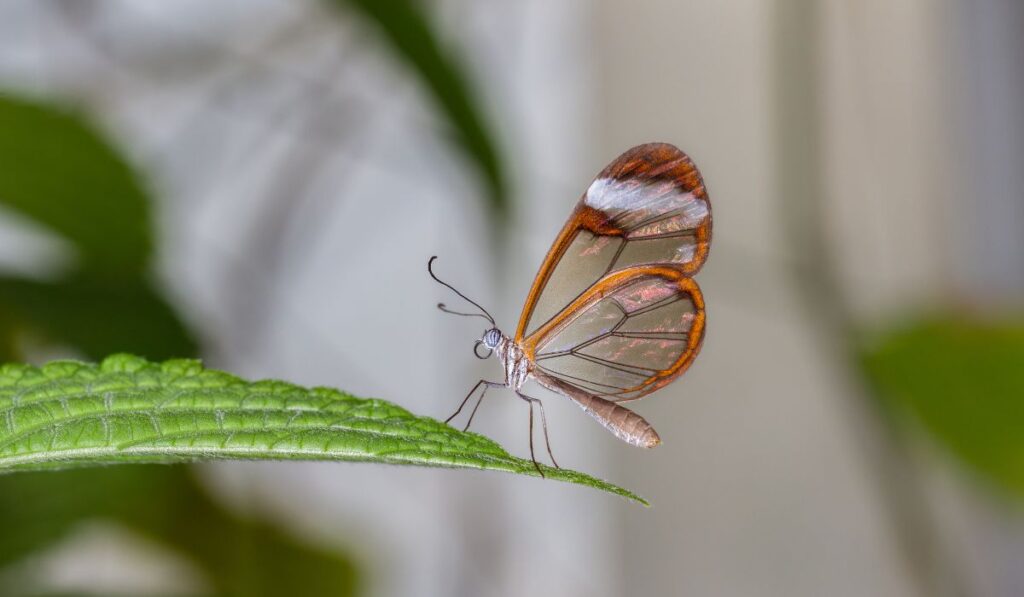
There are over sixty varieties of glass wing butterflies. Their transparent wings make it easy for them to camouflage into their surroundings and hide from predators.
Owl Butterfly
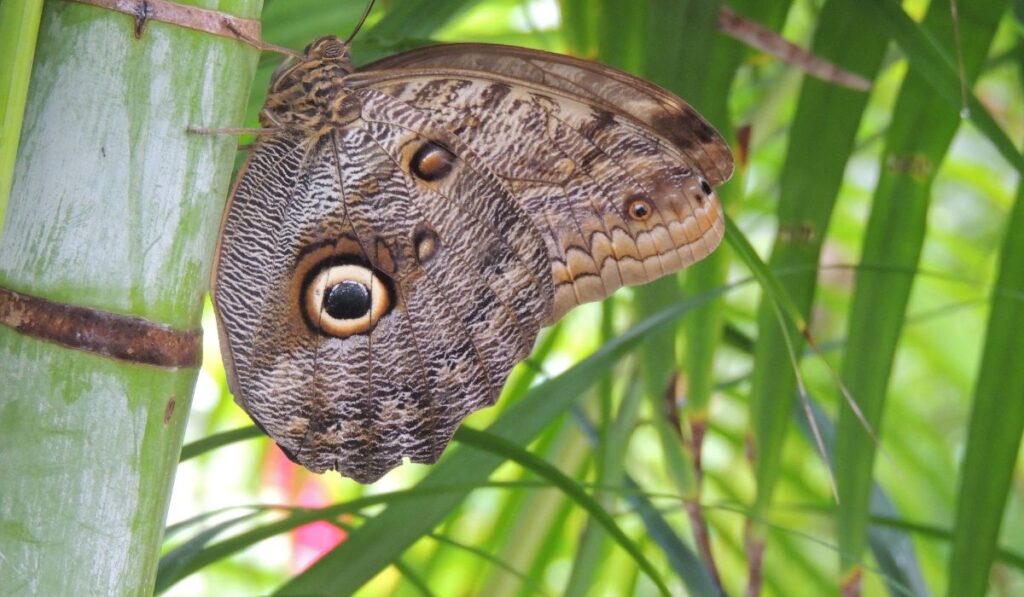
Owl butterflies can be found throughout Central America. It is believed that the large eye pattern on the wings is meant to scare off predators by looking like the eyes of a much larger animal.
Sara Longwing
Sara Longwings are typically found in the rainforest. One of the most interesting things about them is that they continuously reproduce and several generations can be produced within just one year.
Tiger Heliconian
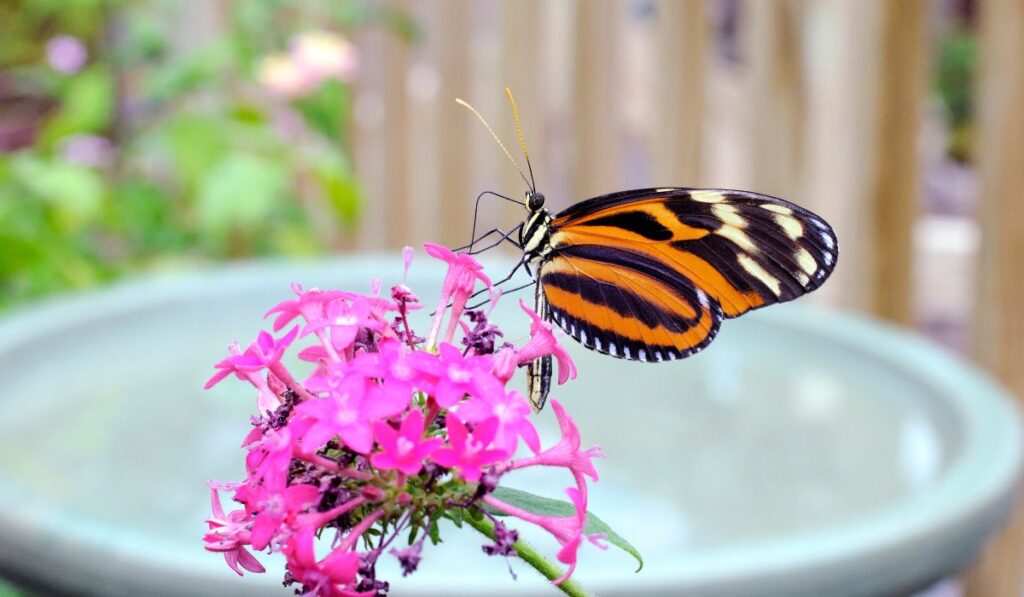
This butterfly can be found throughout Costa Rica in jungle areas. They like sunny areas where they can feed on nectar from various flowers.
Butterfly Sanctuaries in Costa Rica
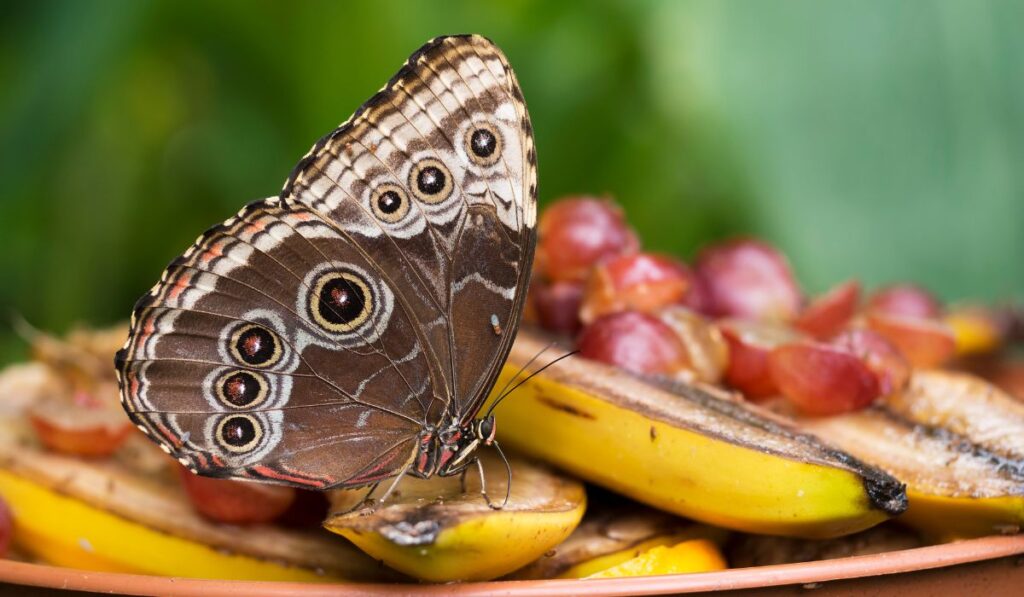
There are multiple butterfly farms/ sanctuaries throughout the country. These are great if you would like to learn more about the butterfly life cycle and see many species up close and personal.
In fact, visiting a butterfly observatory is a great activity for people of all ages. Keep this in mind if you are traveling with family and friends of various ages and interests. You can’t go wrong with a trip to a butterfly observatory!
Here are a few of our favorites throughout the country.
Mariposario Montezuma Gardens- Montezuma
We love Mariposario Montezuma Gardens because they combine a few amazing things in one place. They produce their own delicious craft beer, serve amazing food, and have a nice butterfly garden on the property.
If you opt to visit the butterfly garden, one of their employees will lead you through their butterfly farm to teach and show you the reproduction process with cocoons at different stages.
You can then take your time walking around the butterfly garden to see their wide variety of species.
Tip: Order a beer and bring it with you into the butterfly garden for a really nice experience.
La Paz Waterfall Gardens – Alajuela
La Paz Waterfall Gardens is located less than an hour from the San Jose International Airport. La Paz is a great destination for a fun family day. Here you can see a wide variety of Costa Rican wildlife, learn some history of the country, and visit an amazing waterfall.
The butterfly garden is just one of the many types of Costa Rican wildlife you can see and learn about here.
We have a full guide to visiting La Paz if you would like more info.
Also, you can pre-book your tickets here.
Butterfly Conservatory- Near La Fortuna
I visited the Butterfly Conservatory with my mom and we both loved it! The butterfly conservatory is run by volunteers (who speak English) and are super knowledgeable in all things butterfly. A guide walked us through and explained the different species of butterflies as well as showing us the life cycle process.
It was a great way to see butterflies up close.
This place also has an area with frogs, lizards etc and a nice natural trail with views of Arenal volcano.
If you would like to pre-book a guided tour, you can do that here.
Most Ziplining Places
Many zip lining companies also have butterfly observatories on site. These observatories can usually be visited as part of a combo package. Definitely check when you book your zip lining tour.
Butterfly Life Cycle
One thing I really love about visiting butterfly sanctuaries in Costa Rica is that you will likely get a chance to learn all about the life cycle of butterflies. Most sanctuaries even have an on-site laboratory where you can see the process of eggs to caterpillars to butterfly up close and personal.
Who needs The Very Hungry Caterpillar when you can see it all in real life?
Feel free to use this info to impress your travel partners with your infinite life cycle knowledge.
Most butterflies go through four life cycles from: egg, larva (caterpillar), pupa (chrysalis) and imago (adult).
Egg Phase
Butterfly eggs are laid on plants. Every butterfly species has its own range of host plants which they lay eggs on. The reason for selecting a specific type of plant is because once the egg is hatched into a caterpillar, it will begin to eat the plant it is hatched on to.
A glue like substance on each egg allows them to stick to plants.
Most females produce between 100 and 200 eggs which are either laid singly or in batches.
The egg stage lasts a few weeks in most butterfly species.
Larva Phase (Caterpillar)
Butterfly larvae (caterpillars) eat mostly plant leaves. However, a few species eat ant larvae as well.
Caterpillars mature to the next stage of the butterfly life cycle through a series of developmental stages known as instars. Basically, their skin can not stretch so they need to shed their outgrown skin multiple times as they grow.
Butterfly wing patterns develop in the final instar.
Caterpillars have short antennae, several eyes, and a tubular spinneret which is able to extrude silk.
Pupa Phase (Chrysalis)
When a caterpillar is fully grown it is time to enter the chrysalis phase. In this phase, a caterpillar will first look for a suitable hidden location (usually the underside of a leaf). It will then spin a silk button used to fasten itself to this location. Some caterpillars spin a cocoon to protect themselves, but in actuality, most do not.
From there, the transformation into butterflies begins!
Most of the caterpillar tissue and cells are broken down and the material is rebuilt to create wings. This process is called metamorphosis.
Imago Phase (Adult)
And now we have an adult butterfly!
After a butterfly emerges from the chrysalis phase, it cannot fly until the wings are unfolded. This takes a few hours because it needs to inflate its wings and let them dry.
It is now time to search for a mate and to begin the life cycle over again.
Fun Facts About Butterflies
– Butterflies primarily eat nectar from flowers, rotting fruit, pollen, and tree sap.
– Many butterflies have the ability to camouflage and appear as though they are a leaf, bark etc.
– As an adult, butterflies only live for a few weeks up to a year.
– Butterfly wings are actually transparents. However, they are covered by thousands of tiny scales which reflect the light and make them appear colored.
– Butterflies can’t fly if it is too cold. In other words, Costa Rica is the perfect place for them!
Our Butterfly Tips
– If you do not plan on visiting a butterfly sanctuary in Costa Rica, that does not mean you will not see butterflies. If you plan on visiting any of the Costa Rica national parks, you have a good chance of spotting butterflies there as well.
At most national parks you can hire a guide at the entrance If you are very interested in spotting wildlife, this is the best way to do it.
In our experience, guides are so familiar with the national parks that they know exactly where specific species hang out.
Tell them which wildlife in particular you are interested in spotting and they will do their best to make sure you see them.
– We suggest bringing a pair of pocket binoculars for your trip to Costa Rica. They might not be the most helpful in spotting butterflies (in our experience they fly away too quickly) but for seeing other wildlife, they are definitely great to have.
Let us know if you have any questions about Costa Rica butterflies in the comment section below. We are always happy to help you out!
You Might Also Like:
Costa Rica Travel Details: What You Need to Know
🚗 Should I rent a car in Costa Rica?
Having a rental car will give you the most flexibility when traveling in Costa Rica. This will also allow you to take fun day trips on your own.
- Save 10% Plus Other Perks with Our Adobe Rental Car Discount
- You might also consider; shared shuttle services or private transfer services
🏄🏽 How can I book things to do?
We find that Viator tends to have the most comprehensive selection of activities with secure booking and good cancellation policies.
🍍 I’m overwhelmed with planning. Can you help?
Of course! I suggest joining our Facebook group for specific questions and head to our Start Here Page to get started planning.
✈️ What is the best way to book a flight?
Usually, we have the best luck finding great prices with Skyscanner. Check for flights to both San Jose Airport (SJO) and Liberia Airport (LIR).
🛏️ What is the best way to book my Costa Rica hotels?
We highly suggest Booking.com for hotel bookings and typically use VRBO for Costa Rica vacation rentals.
🗣️What is the main language in Costa Rica?
The main language in Costa Rica is Spanish. Most people working in tourism speak at least some English.
💰 What is the currency in Costa Rica?
The currency used in Costa Rica is the Costa Rican colón (CRC). However, the US dollar is widely accepted in most tourist areas
📞 What is the best way to stay connected?
An eSIM from Airalo is the easiest way to get 4G data while traveling in Costa Rica.
🌴 Is Costa Rica safe?
Generally, Costa Rica is considered safe for tourists. However, like any travel destination, it’s best to use caution and be aware of your surroundings.
🛂 Do you need a passport to go to Costa Rica?
Yes, Costa Rica is its own country. You will need a passport to visit.

Hi! We’re Thomas (the German) and Sarah (the US-er)
We met in Virginia, moved to Germany, and since 2016 we have lived in sunny Costa Rica.
It was a spontaneous decision to move here, but it was the best decision!
Now we spend our days roaming the country to bring you the very best in Costa Rica travel here on Costa Rica Vibes.
Sarah is the writer. Thomas is the one keeping it all together.
Want the whole crazy story?

Sarah McArthur
Sarah McArthur is the co-founder and main writer of Costa Rica Vibes.
She is originally from the United States but has lived in sunny San Jose, Costa Rica since 2016.
She has traveled all over the country and now considers herself a self-proclaimed Costa Rica travel expert.
Want the whole crazy story?

